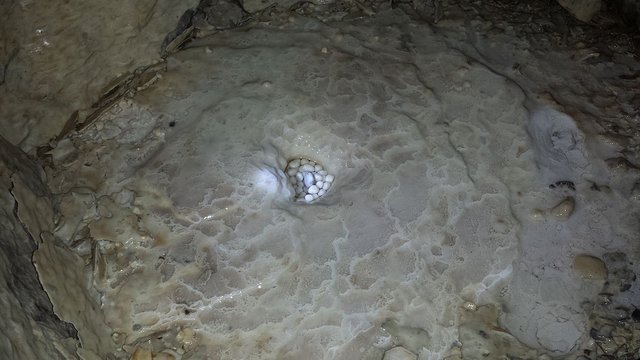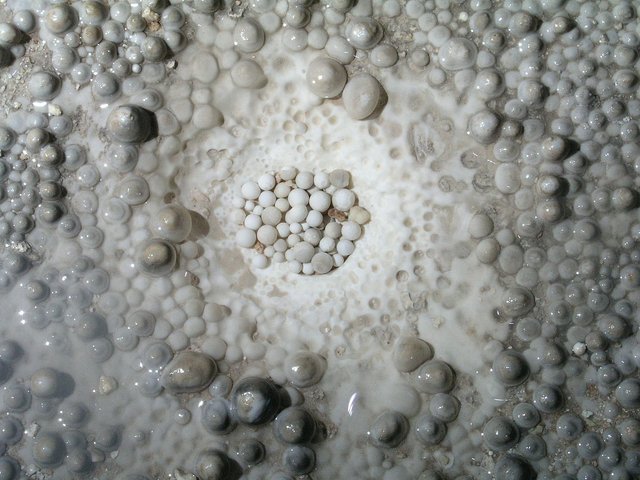Bizarre Natural Phenomena Vol. 64 - A Mother Of Pearls In The Guts Of The Earth (Cave Pearls)
Today I am taking you pearl hunting! No, no, don't put your diver's suit on! This time our pearl hunt will be underground as we will be looking for cave pearls!
Image from: commons.wikimedia.org - Courtesy of: WTucker - License: Licensed under the GFDL by the author; GFDL-SELF-NO-DISCLAIMERS; Released under the GNU Free Documentation License.
Cave pearls? I thought it was a mollusc thing...
Not necessarily... at least considering the shape of them!
Cave pearls are not real pearls, they are made of calcium salts (mainly calcite) inside limestone caves and sometimes in mines. They are basically one type of speleothems (a cool Greek-deriving word for in-cave formations like stalactites and stalagmites). Other than calcite, cave pearls may contain traces of "quartz, apatite, iron, aluminum, and magnesium" . [1]
Another name for them is cave pisoids and despite the word pearl in their name, they are not the ideal jewellery material. Being more porous than real pearls, they turn out to be fragile and can't be used to make jewellery. [1, 2, 8]
But they look like the real deal!
Yes, in some cases they do!
Cave pearls have a "smooth, lustrous surface and regular concentric lamination" [3]. This means they are shiny spheres that grow concentrically as mineral layers "accumulate" over the original nucleus. They are basically spherical, but it's not the only shape they can take cylindrical, elliptical or why not, cubical and hexagonal shapes. Their sizes range from 1-20 cm, with the biggest cave pearls ever recorded being found in Vietnam, in the Son Doong Cave (wikipedia says they were the size of a baseball). They are not to be considered oolites (a sedimentary rock also composed mainly of calcium carbonate) and their chemical composition is such that any contact with the air might cause them to loose their "smoothness" and become rough. [1, 3, 4, 6]
And how are they formed?
Based on observations we can say we have a "model" considering their appearance:
- Saturated water getting inside the cave;
- A flat surface for the water to drip onto (cave pearls need horizontal surfaces to develop);
- A shallow pool. A bowl-like surface is needed for the pearls to grow inside (ideally as deep as deep as 6 cm and not more);
- A nucleus. Even a small grain of sand or quartz sand, tiny bone fragments, wood or plastic will do and work as the "base" on which the pearl will develop;
- Conditions that lead to the formation of layers within the pool;
- Chemical substances or small particles from the water that either bring detrital or authigenic clays or feed a microbial population within the cave. [2]
Now, let's explain a little more:
As saturated water makes it inside a cave and loses CO2, it causes the precipitation of minerals. When these minerals find a free nuclei, they gather around it and little by little form beautiful spherical shapes. The minerals are deposited in layers and are usually "calcium carbonate (calcite or aragonite – CaCO3), or calcium sulphate (gypsum – CaSO4 2H2O)" [5]. The constant dribbling water movement needs to retain a certain "speed" (not too fast to destroy the sphere, neither too slow for the sphere to "stick" on the pool floor), the nucleus then keeps rolling around the flat pool inside the cave and it is this movement that gives the characteristic spherical shapes to the pearls (it grinds them and makes them characteristically round). Once they grow over a certain size, the water is not "strong" enough to keep rolling them around and they start to get "cemented" on the pool floor. [5]
Keep in mind that if the water was dripping a liiittle more slowly, then we would have a pretty stalagmite instead. [6]

Image from: commons.wikimedia.org - Courtesy of: Darkbluejacket - License: CC BY-SA 3.0
The role of bacteria
Observations of cave pearls in Perlova Cave (Slovakia) focused on the role of bacteria in the formation of cave pearls of irregular shapes. These cave pearls do not grow as spheres around a nucleus and a thin biofilm was found on their outer layers consisting of " live microbial cells, their extracellurar polymeric substances and a mineral fraction" [3]. The mineral fractions were mainly calcitic replicas of microbes, which means that living or dead microbes were calcified in order to act as a nucleus for the cave pearls. Calcite crystals then started growing over them and create the cave pearls. Chemolithoautrophic hydrogen-oxidising bacteria also seem to play an important role in the calcification process here, as they consumed CO2 and lead to calcite secretion within the pearl's "body". [3, 7]
The biofilm on the surface plays a role too. The biofilm is responsible for the calcite precipitation in the water and causes the "embodiment" of non-calcite mineral grains within the pearl. It also works as a protective "shield" for the pearl when disturbances (like a change in the water's pH) occur. [3, 7]
(For more details on the role of bacteria, you can go through the 3rd link in the references.)
They have a story to speak
There is a theory suggesting that cave pearls may be able to reveal secrets about climate changes in the past. Measurements in the oxygen isotope ratios inside them would probably provide interesting data, but the method is still under examination. [5]
I want to see them!
To find cave pearls you need to find... a limestone cave first 😜
There are two caves in America though that are famous for having more cave pearls than any other cave in the world: the Cave of Marbles (Tabasco, Mexico) that is estimated to hide about 200 million pearls inside it and the Carlsbad Caverns (New Mexico, US), also known as the Rookery. [5]
(Click on the Cave of Marbles link, the photos will surely impress you!)
References
[1] wikipedia.org
[2] pubs.geoscienceworld.org
[3] sbe.com.br
[4] goodearthgraphics.com
[5] the-earth-story.com
[6] worldatlas.com
[7] researchgate.net
[8] langantiques.com

Thank you so much for your time!
Until my next post,
Steem on and keep smiling, people!



Very cool that bacteria can play a role in shaping something that takes so long to develop.
What really impressed me is the harmony in which they work together.
Most beautiful things are usually hidden inside the cave or buried underneath the sea.
This means beauty is not easy to get, you need to search for it :P
These cave pearls remind me of the "blueberries" on Mars.
https://en.wikipedia.org/wiki/Martian_spherules
I will leave that topic for you for a future post if you want.
Ooooh! Pretty! Thanks a lot! :D
Martian spherules
Martian spherules (also known as blueberries due to their blue hue in false-color images released by NASA) are the abundant spherical hematite inclusions discovered by the Mars rover Opportunity at Meridiani Planum on the planet Mars. They are found in situ embedded in a sulfate salt evaporitic matrix, and also loose on the surface.
Nature never ceases to wow us. When I saw the "pearl" in the title, I knew I was about to witness a spectacle - and yes; the post wasn't short of that.
I'm thinking, can these cave pearls be harvested and used to construct some kindda decoration stuff? (Co-built by nature and human). Now I'm sounding weird, lol.
Nice piece as usual, Ruthie
Would you like to decorate your garden with those? :P
I think they'd lose their shiny appearance once they got out of the cave...
Thanks for coming over, Sammy! :)
Lol. I wouldn't mind that for my garden. 😂
AKA bone
Really?!
Yep!
Beautiful! Thanks for sharing these secrets of nature...
Thanks! Somebody had shown me that in a comment some weeks ago (but I can't remember who it was...)
This post has been voted on by the steemstem curation team and voting trail.
There is more to SteemSTEM than just writing posts, check here for some more tips on being a community member. You can also join our discord here to get to know the rest of the community!
A totally natural process capable of molding spherical shapes. Nature and its wonders! We will continue learning!
Thanks for sharing
Thank you for stopping by @ufv! :D
Okay now I'm officially jealous, all these awesomely cool stuff happening outside Africa (though we have the ikogosi warm springs and some other resort centres), but If i get the chance, I'm definitely bringing one of those shiny little balls back home :)
Don't worry, there's not much bizareness in Greece either :P
(How cool is that spring you just shared!)
Thanks for reading @moshroom! :)
Very interesting, specially the bacteria role, I'm a biologist. Please don't stop doings science communication.
Thank you very much! :)